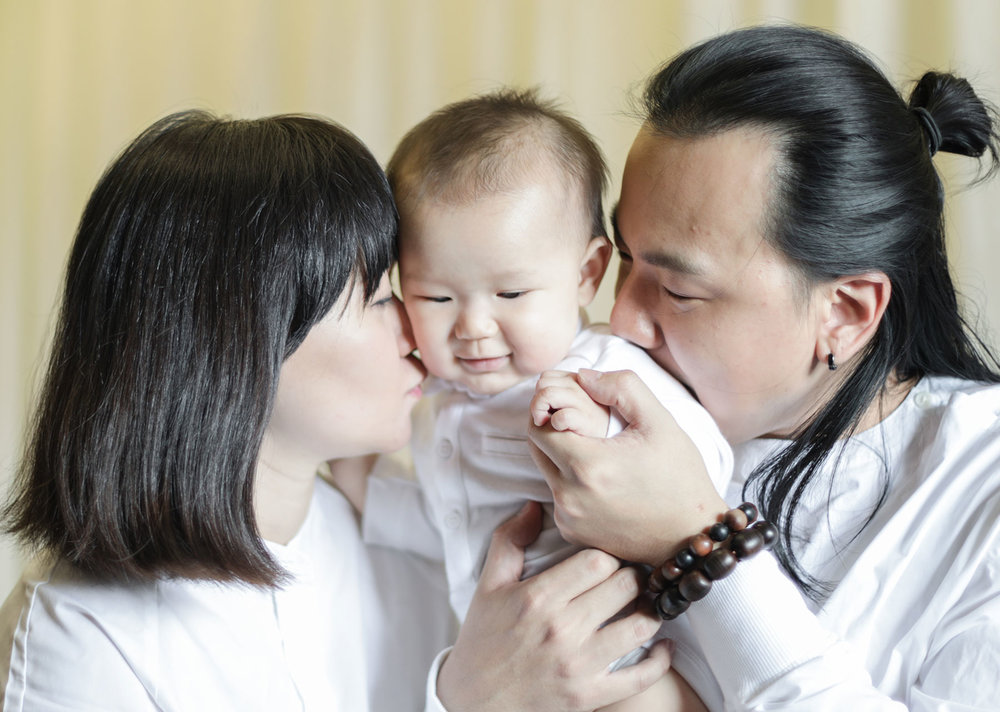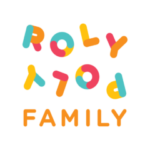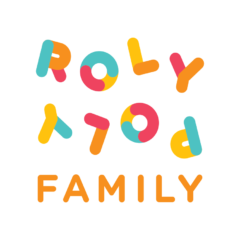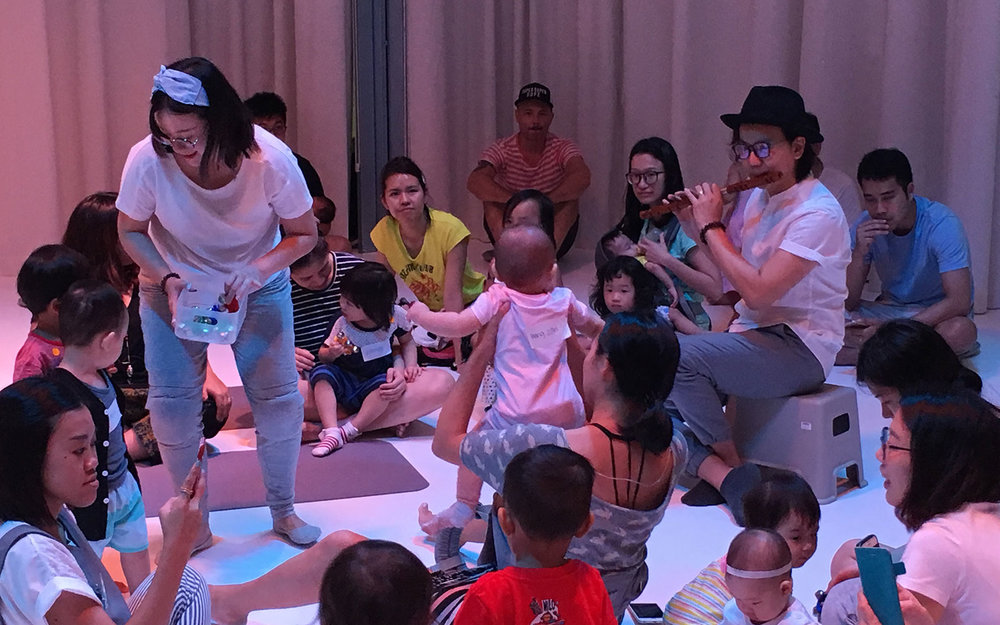Making Extraordinary Sounds With and For Babies : An interview with Andy Chia and Natalie Alexandra Tse (Little Creatures by SA)
This is part of a series of interviews with families that make art and perform/exhibit together. We hope there is something here for you.
We are delighted to be sharing this written interview with Natalie Alexandra Tse and Andy Chia from SAtheCollective. With the birth of their son Dodo, Nat and Andy began making performances together as Little Creatures by SA. Read on to find out more about Nadam (their latest performance for babies), what making art with each other and their son means to them, and why the “older generation” might wag their fingers at this pair of artist parents.
Thanks, Andy and Nat, for opening up to us!
Could you give us a brief history of how you started working together and what led to making performances with Dodo?
We met more than 15 years ago when we played in an out-of-school Chinese Orchestra that gathered some of the prominent youth Chinese instrumentalists back then. After completing our respective Masters programmes, we formed our first East-West “fusion” kind of band. Eventually, SA was established as a trio with the Chinese dizi, guzheng and drums & percussion. Now, SA has evolved and expanded into an Art Company – SAtheCollective. Our artistic pursuit is no longer limited to Chinese instruments or music – we pride ourselves as a company that is focused on cross-cultural, cross-disciplinary creative collaborations and we have associate artists who dabble in the realm of audio-visual art.
With the company, we found it increasingly important to advocate for a generation of arts audiences who are aware. This is in line with Nat’s pursuits at NIE in early childhood music education, where she currently pursues a PhD. Little Creatures by SA was thus established in 2016, dedicated to creating opportunities for the very young audience (newborns till 8 year olds) to play, explore and experiment with sonic possibilities. With our little one Baby Dodo, who came along in 2018, we developed a performance for babies – Nadam – that is rooted in Chinese philosophies and explores natural sonic objects such as gourds, bamboo, and wood.
How do your roles in the family now intersect with your roles as you make art together?
While we keep our working relationship professional, it’s undeniable that many times, our lives are highly intertwined with art-making. I think over the years, and with Baby Dodo now, we have learnt to be one with our Art, working with each others’ capabilities, strengths, weaknesses and differences much more cohesively. For example, Nat is generally weaker at the visual arts. Andy helped a lot with designing the set and the props, since he is a lot more visually-inclined. Andy has a more “doing” approach to Art, while Nat is a little more “conceptual,” so we complement well.
Dodo is with us everywhere we go. He is basically attached to us all the time. We do not leave him with others. On the rare occasions when we do, he would be in the vicinity. For example, when we have to perform together in a show like ETHNI-CITYIII, or when he is grouchy and may serve as a disruption during Nadam, our fellow artist friends will help to care for him. SAtheCollective has become a tight-knit family and Dodo is definitely one reason for our bond. As Dodo’s mum, Nat wants to be with and provide for him all the time. Having to juggle between him and her passion for the arts for young children feels ironic at times.

We were at Nadam and saw how the babies displayed different responses to the sounds, the movement, the performers and the environment. The work seemed to offer a comfortable and intriguing space for them to experience different textures of sounds and materials. Could you tell us more about Nadam?
Nadam is rooted in Chinese philosophy – the concept of Heaven, Earth and Man, its relationship with one another, and the harmony of Man in Universe and the Universe in Man. It also rides on the concept of Eight Sounds/Eight Tones – an ancient philosophy of the eight different materials that make sound, including bamboo, stone, strings (silk), gourd, clay, etc.
In the development of Nadam, we considered the use and representation of these materials as sounding objects that are safe for babies 18 months and below to explore and play with. We advocated for deepened awareness of listening. Sound is one of the earliest senses to develop when we are fetuses in our mothers’ wombs (around 20 weeks) and the last sense that leaves as we pass on. For babies, sounds, such as their mothers’ voices, are soothing and serve as a form of emotional communication that is crucial to a babies’ survival as their cries indicate their needs.
Sound is all around us, yet we are hardly aware of it. At the same time, sound also exists within us – and that’s the actual meaning of the sanskrit word, “Nadam”, which some of us may find akin to “Om,” commonly used in yogic practices. Some practices also believe in the resonant harmony in our bodies that keeps ourselves calm and balanced. Sound is very important to the well-being of humankind.
How did each of you contribute to the creation and performance of Nadam? Who else was instrumental in the work and in what way?
Baby Dodo was a major part in the creation of Nadam – he was present during all the meetings and rehearsal sessions. He grew with the performance, as much as the performance developed with him. We witnessed developmental milestones such as him crawling, standing, walking and vocalizing along with us during the performance itself.
He helped us understand how to interact with babies through his actions and responses to the events that were happening during workshop and rehearsal sessions. In a way, he was a little “test subject” of ours, though a very “biased” one. He reminded us how important it is give him possibilities and potentialities for exploration, even though there are people who question us, saying things like “he understands meh?” or “he’s too young to know.” We think that’s absolutely untrue. If we don’t give our babies opportunities to experience and explore, the neurons that are supposed to fire will not, and his experiences and later outlook towards life will be limited. This is one of the driving forces and objectives behind Nadam as well – to allow babies to experience extraordinary sounds.
Andy was crucial in directing the music and creating the house-music that we hear at the beginning of the show. We took inspiration from sounds we imagined hearing as fetuses in our mothers’ bodies – heartbeat, nervous system, blood circulation, etc. Andy was also central in creating the rather elaborate performance space setup.
Nat was the overall director of the performance. It being her first attempt, she received a lot of help from the team, such as Renee Chua, who guided the dramaturgy, movement, and prop-building, and Vick Low, a friend who helped with sound, building props and looking after Dodo. Others in the team included Raywyn Tan, Chengyan Ang, Waikit Chan and our lighting deisgner, prop-maker and stage manager.
What were the most satisfying and the most challenging moments in NADAM?
We all doubled up on the roles – from musician, actor, and movement artist to set-design and prop-making. It was definitely challenging to try to wear so many different hats.
During the show, Dodo’s responses affected us (he was there for most of the actual performances). For example, Nat sub-consciously looked out for him at all times, no matter who his caregiver was, and she panicked whenever he got grouchy or sounded agitated. Though she liked when he came up to her as she played the harp, she was also worried that he would cry if his caregiver pulled him away from her. We believe that babies communicate their needs through cries that affect the parents’ emotions. Dodo’s cries of sleepiness, for example, made Nat’s heart skip a beat during performances while she tried her best to stay focused.
To actually present the show and see parents gain this new experience with their babies (it was the first time for many of them) was the most satisfying part. Seeing how our team bonded and grew with one another was also valuable.

What have been the implications of the way you live and make art as a family?
I think our parenting style can be rather different. For instance, Dodo has never been bottle-fed (save for once when I tried). He can be said to be a purely breastfed, breast-nursed baby, even till today (shy of 2 weeks to 12 months old). He has attended all sorts of arts events and witnessed different art forms. We intend to keep it this way and to give him varied arts and life experiences. His sleep pattern is the same as ours – night owls we all are, and late risers too. He doesn’t have daily routines; we go with the flow. I think if the older generation were to know of our parenting style, we may be heavily criticized. But we stand by our style and values and believe the importance of keeping our child close to us. We believe that giving Dodo a strong sense of attachment in his early years, when he needs it the most, is important, helping him feel secure and confident as we gradually raise an independent young person. He may be attached to us, but he’s one of the friendliest babies we’ve ever known. He says “hi” to everyone, explores curiously and is able to simply just be.
Thank you, Andy and Nat, for sharing about your philosophy and way of working, both in your performances and in your family life together. We look forward to more conversations with you!
For more information about Little Creatures by SA and Nadam:
Little Creatures by SA – http://littlecreaturessg.com/
Nadam – http://littlecreaturessg.com/work/lc/nadam


